
About UsThe Numismatic Bibliomania Society is a non-profit organization promoting numismatic literature. For more information please see our web site at coinbooks.org SubscriptionsThose wishing to become new E-Sylum subscribers (or wishing to Unsubscribe) can go to the following web page link MembershipThere is a membership application available on the web site Membership Application To join, print the application and return it with your check to the address printed on the application. Membership is only $15 to addresses in the U.S., $20 for First Class mail, and $25 elsewhere. For those without web access, write to: David M. Sundman, Treasurer AsylumFor Asylum mailing address changes and other membership questions, contact David at this email address: dsundman@LittletonCoin.com SubmissionsTo submit items for publication in The E-Sylum, just Reply to this message, or write to the Editor at this address: whomren@gmail.com
BUY THE BOOK BEFORE THE COIN |
- WAYNE'S WORDS: THE E-SYLUM JANUARY 26, 2014
- THE JOHN H. BURNS MEMORIAL FUND
- AUTHOR FRED REED SIDELINED BY ILLNESS
- BOOK REVIEW: ROMANIA TOKENS, TAGS AND CHIPS
- BOOK REVIEW: HUNGARIAN TRANSPORTATION TOKENS
- BOOK REVIEW: THE NATIONAL COIN ALBUM
- SELECTIONS FROM THE SKLOW LITERATURE SALE #21
- CHRISTOPHER EIMER ON THE AUGUSTIN DUPRE ARCHIVE
- NOTES FROM E-SYLUM READERS: JANUARY 26, 2014
- TALE OF THE TAPE: PITTMAN, BREEN AND THE TAXAY BOOK BLURB
- DAVID PROSKEY AND THE PROSKEY BROS. CARDBOARD CHITS
- HIDDEN IMAGES: THE RAT HALFPENNY
- MEDALS OF THE LITERARY SOCIETY OF KING’S COLLEGE
- ATLANTA ANA EXHIBITS: EVENT OR ROUTINE?
- WAYNE'S NUMISMATIC DIARY: JANUARY 26, 2014
- MINT TESTING COPPER-PLATED ZINC FOR 5-CENT COIN
- MORE ON THE NEW ENGLAND MEDALS BOOK SERIES
- SAINT-GAUDENS DIANA STATUE RESTORATION
- MORE ON NUMISMATIC POSTCARDS
- COIN CIGARETTE CARDS
- URSULA KAMPMANN: VISITING THE NEW YORK INTERNATIONAL
- EBAY BANKNOTE SCAMMER INDICTED
- THE EDWARDS CATALOGUE OF IMPERIAL GOLD COINS
- GOLD QUARTER STATER MYSTERY
- WOMAN BUSTED FOR PASSING 'MOE MONEY'
- CHINESE LAI-SEE MONEY
- CHINESE BANKNOTES STAMPED WITH FIREWALL-DEFECTING CODES
- FEATURED WEB SITE: PHILIP AND HAROLD MERNICK
Click here to access the complete archive
To comment or submit articles, reply to whomren@gmail.com
WAYNE'S WORDS: THE E-SYLUM JANUARY 26, 2014

The Eastern U.S. has gotten a lot of cold weather and snow this week. My kids have been off school all week, and very bored by the time I get home each evening. I've played many an indoor basketball game and Monopoly game.
But somehow, between school sporting events and family dinners this weekend I've managed to pull together another issue of The E-Sylum, with the help of numerous contributors who forwarded content for my ham-handed cut and paste treatment.
This week we open with an announcement of the John H. Burns Memorial Fund; readers are encouraged to consider a donation to remember the late numismatic literature dealer and help build an enduring means of promoting numismatic research, publishing, and knowledge. Next up are reviews of three numismatic books and a couple selections from the upcoming Sklow literature sale.
Other topics include the Augustin Dupre archive, Don Taxay, John Pittman, Walter Breen, David Proskey, Wayte Raymond, and M. L. Beistle, Saint-Gaudens' Diana statue, coin cigarette cards and Lai-See money.
To learn more about the Rat Halfpenny, the first civilian medals produced in the American colonies, Romanian and Hungarian tokens, the National Coin Album, the Mint's experimental copper-plated zinc Jefferson 5-cent coins, the Edwards catalogue of imperial gold coins, 'Moe Money', and one of greatest numismatic April Fool's Day pranks ever executed, read on. Have a great week, everyone!
Wayne Homren
Editor, The E-Sylum
THE JOHN H. BURNS MEMORIAL FUND
Pat McBride writes:
I have a few updates that Wayne Homren and I have been quietly proceeding with. We have a lawyer to proceed with granting administrative and executor status to tend to John's affairs. I contacted a cremation service and signed the proper release form to have John cremated, like his parents before him. His remains would be returned to Pennsylvania and a respectful ceremony will be decided at a later date. His mother's remains are still at the funeral home here. John could not muster the strength to pick her up. His dad's remains are in his town house.
There has been a movement in Pittsburgh to have a donation fund created under the umbrella of the Pennsylvania Association of Numismatists (PAN) with PAN Board review that would be transparent and through a non-profit rather than privately managed. Wayne and I are faced with the burden of cost to get things accomplished until some of John's assets can be sold. A donation fund would be very helpful.
If I am granted executor status through the court, and that seems likely so far, then I may go to Orlando and return John's cargo van, inventory, and personal property back to his storage facility. This would allow us to catalogue and dispose of John's property and retire his debts the best way possible. Together with John's many friends we can see this to a successful conclusion.
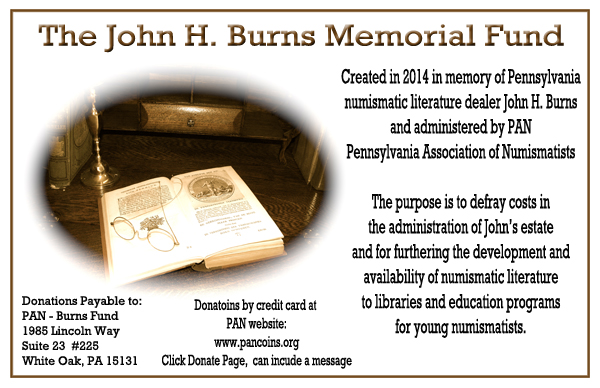
We'll close this week with a photo of John (and others, including me) in younger days. Thanks again for your support. -Editor
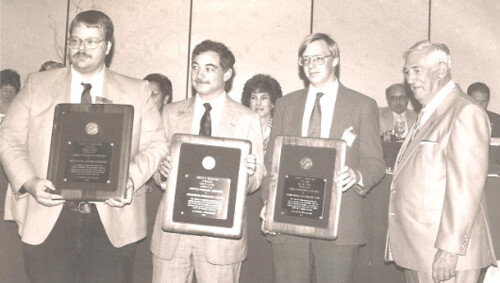
John Burns, Richard Crosby, Wayne Homren, Steven Taylor
1989 Pittsburgh ANA Convention (image courtesy Richard Crosby)
To read the earlier E-Sylum article, see: MORE NOTES ON JOHN BURNS (www.coinbooks.org/esylum_v17n03a09.html)
AUTHOR FRED REED SIDELINED BY ILLNESS
The family of numismatic author Fred L. Reed lll sent this announcement for publication:
Author and numismatic enthusiast Fred Reed became suddenly ill in early December and is continuing along the road to recovery. His family is assisting him and asks that his many friends and well-wishers to please refrain from e-mailing him as they want to focus their efforts on helping his recovery and not keeping up with e-mail from his many friends. Instead they ask that if you would like, to simply send your notes and cards to him at P.O. Box 572022, Dallas, TX 75357.
If you have previously ordered copies of his books, the family asks your patience as they work through shipment of the book orders. If you have not ordered one, there still are a limited number copies of version 2 of Fred's popular book on Civil War Stamp Envelopes still available in hardback for $89.95 (including S/H). To obtain a copy send a check or money order to the above P.O. Box.
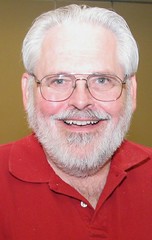 I was very sorry to hear the news about Fred's struggles. I got to know him back in the 1980s when we collaborated on his book on Civil War Encased Stamps. Fred is the consummate numismatic researcher, doggedly pursuing every lead, analyzing each bit of evidence, fitting them into the puzzle, and in due time writing a compelling narrative description of the known facts. His books are among the best ever written in American numismatics.
I was very sorry to hear the news about Fred's struggles. I got to know him back in the 1980s when we collaborated on his book on Civil War Encased Stamps. Fred is the consummate numismatic researcher, doggedly pursuing every lead, analyzing each bit of evidence, fitting them into the puzzle, and in due time writing a compelling narrative description of the known facts. His books are among the best ever written in American numismatics.
We wish Fred all the best in his recovery. He's been a VERY busy guy. In addition to his book writing, he publishes a regular column in Bank Note Reporter and serves as editor of BOTH Paper Money (for the Society of paper Money Collectors) and the TAMS Journal (for the Token and Medal Society). Both organizations are making arrangements to continue publication in Fred's absence. Below is more information. -Editor
SPMC President Pierre Fricke writes:
Fred has made tremendous contributions to our Society. We miss him and our thoughts and prayers are with him and his family. We hope for a speedy recovery. In the meantime, we've taken on the difficult task to backfill Fred on a temporary basis. Secretary Benny Bolin has stepped up as a temporary editor. Benny led the charge with help from others such as past-President Mark Anderson to get the January-February Paper Money magazine out.
Benny is now working with others on the March-April issue. We are asking members who have sent contributions to the magazine such as ads, articles and checks to Fred or is looking to send new ads, articles and checks to send them to Benny Bolin at 5510 Bolin Road, Allen, TX 75002. He may be emailed at smcbb@sbcglobal.net. President Pierre Fricke may be reached via email at pfricke@csaquotes.com.
TAMS President John Mutch writes:
On behalf of the Board of Directors and membership of the Token and Medal Society, I’d like to send our best wishes to Fred and his caregivers.
TAMS is making arrangements with an interim team to keep the TAMS Journal on the successful track that Fred has established. Fred will continue on our masthead as Editor until he is in a position to make a decision about his ability to continue.
TAMS has been fortunate to have a lot of help in getting out the next issue of the Journal while we put the interim group in place. The offers of support are a testament to the good will Fred has created in our hobby.
For more information about SPMC and TAMS, see:
www.spmc.org
www.tokenandmedal.org
BOOK REVIEW: ROMANIA TOKENS, TAGS AND CHIPS
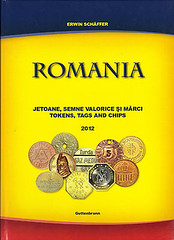 As speculated about in the January 12 issue of The E-Sylum, Erwin Schäffer
did indeed switch from Romanian/German to Romanian/English between his
2003 and 2012 works. I'll point out that the English is occasionally a
touch eccentric, but it is perfectly usable by the English speaker, and
is certainly welcome here.
As speculated about in the January 12 issue of The E-Sylum, Erwin Schäffer
did indeed switch from Romanian/German to Romanian/English between his
2003 and 2012 works. I'll point out that the English is occasionally a
touch eccentric, but it is perfectly usable by the English speaker, and
is certainly welcome here.
The size of the book has increased from 592 pages, 20cm high, to 462 pages, 29.5cm high. The larger page size allows for a considerable increase in the number of tokens covered per page, so the decrease in page count is deceptive. The 2012 edition also includes a CD-ROM with several auxiliary indices and an additional chapter, "Foreign Tokens Used in Romania."
In all, there is a considerable increase in the included information. As happens so often, the publication of the first catalog in 2003 seems to have been instrumental in shaking loose information about tokens unknown to the author. I've included the first page of the actual token listings, where you'll note that the Restaurantul Gărei gained a 5 Lei token, a color photo (there's a considerable increase in color), and a new numbering system that appears much more amenable to inserting new discoveries.
There are a couple of entirely new chapters noted by the author, including mining and quarry tokens, and the ever important "'Dracula' pieces."
As for me, I'm happy that the section on telephone tokens is up to 12 pages and includes a very nice overview of the history of the associated telephone companies. Of course, there's always something missing, in this case the old photograph of the Bucureşti Palatul Telefoanelor (literally the Telephone Palace, a glorious name for a central office) has been dropped in the 2012 book.
I'd consider this the essential catalog for Romanian tokens, even though, as the author freely admits, it is perpetually a work in progress.
Schäffer, Erwin. Romania: Jetoane, Semne Valorice Şi Mărci / Tokens, Tags and Chips. Bretzfeld, Germany: Self-published, 2012. 462 pp + CD-ROM. 29.5cm [Currently available on www.ebay.com from cartelcoserv, Gabriel Iliescu, but not through normal bookseller channels so far as I know.]
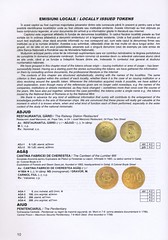
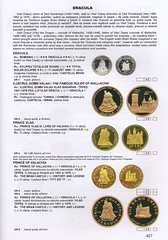
To read the earlier E-Sylum article, see: NEW BOOK: ROMANIA TOKENS, TAGS AND CHIPS (www.coinbooks.org/esylum_v17n02a06.html)
BOOK REVIEW: HUNGARIAN TRANSPORTATION TOKENS
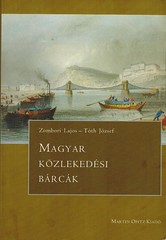 I promised to find information on that token book Magyar Közlekdési Bárcák. The only listing I could find was an antiquarian book site
bookline.hu. This site is only in Hungarian, not easy for a English reader.
I bought a copy.
I promised to find information on that token book Magyar Közlekdési Bárcák. The only listing I could find was an antiquarian book site
bookline.hu. This site is only in Hungarian, not easy for a English reader.
I bought a copy.
It is listed for 3000Ft, about $14 at current exchange. I have no idea what the overseas shipping charges would be.
The best thing is that each item is pictured. If a token was struck in more than one metal, all are listed. There is a Hungarian-English vocabulary of the key words. About half the listings are paper items, which I would call tickets. The biggest disappointment to me is that rarity is not given. It has card covers, 237 pages.
To read the complete article, see: NEW BOOK: HUNGARIAN TRANSPORTATION TOKENS (www.coinbooks.org/esylum_v17n01a04.html)
THE BOOK BAZARRE
BOOK REVIEW: THE NATIONAL COIN ALBUM
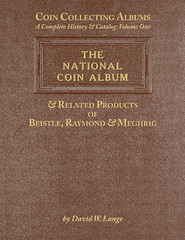 David W. Lange’s new book, Coin Collecting Albums – A Complete History & Catalog Volume One: The National Coin Album & Related Products of Beistle, Raymond & Meghrig, is a landmark effort, lavishly produced and well worthy of inclusion in the library of every numismatist - particularly, but not limited to those in the United States.
The book's press release summed it up well as follows:
David W. Lange’s new book, Coin Collecting Albums – A Complete History & Catalog Volume One: The National Coin Album & Related Products of Beistle, Raymond & Meghrig, is a landmark effort, lavishly produced and well worthy of inclusion in the library of every numismatist - particularly, but not limited to those in the United States.
The book's press release summed it up well as follows:
Thoroughly researched and richly illustrated, this book is nearly 300 pages long, including 80 pages in full color. Portraits of the individual publishers, their business locations and original documents are among the hundreds of images.
All types of albums produced by the three named publishers are illustrated, and included are numerous detail images that reveal their distinctive features for ease of identification within the catalog pages. The several catalogs within the book provide each album entry with a unique Lange Number for exact communication between collectors.
Lange’s new book is hard covered and is printed entirely on 100-pound coated stock. This is a high quality book that is meant to last, and its cover actually reproduces the image of a National Coin Album binder. It is also anticipated that this will be the first in a multi-volume series of books relating the entire history of coin albums and folders published in the USA.
E-Sylum readers will be interested to learn of the connection of these ubiquitous albums to a famous U.S. numismatic author. Here's how Lange tells the story:
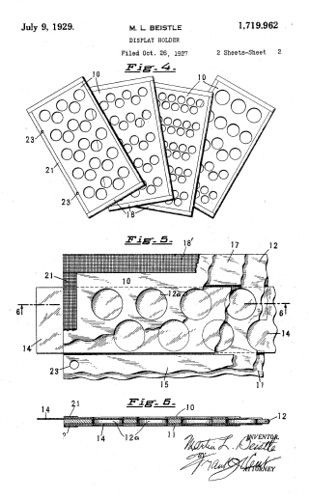 The very first coin album began as a product devised by one individual to house his own collection of half dollars. M. L. Beistle is best remembered in numismatics for his 1929 book, A Register of Half Dollar Die Varieties and Sub-Varieties. This was primarily a labor of love, and it proved to be one of his very few endeavors that failed to make a good return on investment.
The very first coin album began as a product devised by one individual to house his own collection of half dollars. M. L. Beistle is best remembered in numismatics for his 1929 book, A Register of Half Dollar Die Varieties and Sub-Varieties. This was primarily a labor of love, and it proved to be one of his very few endeavors that failed to make a good return on investment.
Published just in time for the Great Depression, sales were sluggish, and many copies remained on hand at the time of his death in 1935. He enjoyed far greater success with a simple tool he devised to assist him in examining his collection.
In his study of these coins to determine all of their varieties, Beistle found it cumbersome to use a coin cabinet or paper envelopes for storage, and this prompted him to devise a quicker method of making side-by-side comparisons of coins having the same date. With his knowledge of paper products, and having his own company to manufacture these to exact specifications, Beistle was in an ideal position to see his vision realized. Thus was created in 1927 the Unique Coin Holder.
Rather than attempt to describe this product in detail, it will be easier for readers if I simply call it the ancestor of the familiar Wayte Raymond National Coin Album, as most collectors having an interest in vintage coin albums will immediately recognize the basic features of both. Initially there was only one size of Unique Coin Holder, and this conforms to the large size or portrait format National album. It also lacked a binder, instead having separate panels that served as front and back covers with the connecting rings exposed. Beistle also developed a slipcover to hold unbound pages, and these accessories are described more fully below under “The Unique Coin Holder.”
While Beistle initially produced his invention with openings for half dollars alone, he was an astute businessman who quickly realized the commercial possibilities of offering this product with a variety of opening sizes for all USA coins. The hobby was desperately in need of something that was both practical and attractive, as all that existed at the time were expensive and bulky wooden cabinets or simple paper envelopes. (p2)
Beistle was an inventor and manufacturer, but could only do so much to market his product on his own. For that, he needed a partner. The following excerpts from the Lange book explain what happened next:
M. L. Beistle’s Unique Coin Holder was a sound concept, and by 1930 it was also a proven seller. Beistle marketed his new product to hobbyists through ads in The Numismatist, yet he did not command a major presence in the coin market. Wayte Raymond, however, was an established and well connected dealer, and he had been among the earliest buyers of Unique holders. Raymond thus saw the Unique holder’s broader potential for selling large quantities of coins during the bleak years of the Great Depression. By the fall of 1930 Raymond had struck a deal with Beistle to become the exclusive distributor of Unique holders through the Scott Stamp & Coin Company in New York. Raymond’s connection to this product was not publicized until several years later, though it was clearly known to most of his fellow dealers.
Wayte Raymond set about working with the Beistle Company to upgrade the Unique Coin Holder’s appearance and utility. The separate front and back covers of Beistle’s devising were replaced with a wrap-around cover, to which the binding rings were attached on the inside of the spine. This had the desired effect of making the whole ensemble of binder and pages look more like a book, and Raymond renamed this revised product THE NATIONAL COIN ALBUM. In this form these albums became the mainstay at the upper end of the coin storage market for nearly 30 years, until being supplanted by better albums of competing publishers in the late 1950s. (p58)
Raymond realized that the wooden coin cabinets common in previous centuries were too costly and awkward for the middle class hobbyist he was seeking, and he further understood that the simple paper envelopes then widely used were aesthetically unsatisfying. Therefore, Raymond acquired the rights to Beistle’s Unique Coin Holder and upgraded it to THE NATIONAL COIN ALBUM so familiar to collectors of the 1930s-50s. The Beistle Company remained the exclusive manufacturer of National Coin Albums and the other Raymond coin storage products, but it never again advertised them under its own name. (p59)
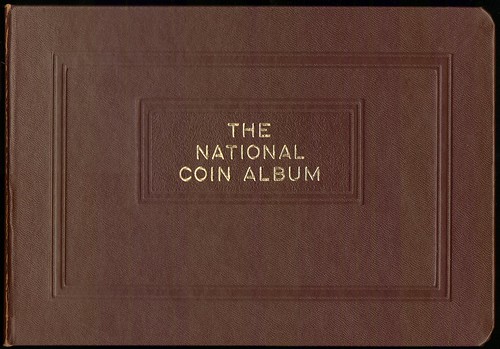
Raymond National Coin Album Small Binder
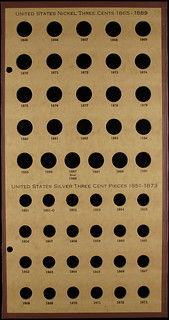 Lange's research indicates that Wayte Raymond entered the coin album business in part to move the hoards of minor coins he had acquired from David Proskey and other dealers of the previous generation. Sets of three-cent pieces were easy and inexpensive to assemble in the 1930s-40s. At right is an image of the combined Three Cent Nickel / Three Cent Silver holder.
Lange's research indicates that Wayte Raymond entered the coin album business in part to move the hoards of minor coins he had acquired from David Proskey and other dealers of the previous generation. Sets of three-cent pieces were easy and inexpensive to assemble in the 1930s-40s. At right is an image of the combined Three Cent Nickel / Three Cent Silver holder.
The above relates on a small part of the overall story of The National Coin Album and its impact on the U.S. numismatic hobby. Lange's book carries their story through to the present day.
The book is a delight to read, with many interesting anecdotes of hobby history. One piece of trivia many E-Sylum readers are aware of is the main product of M. L. Beistle's company - paper holiday decorations. I was happy to see the inclusion of images of two of the firm's anniversary medals.
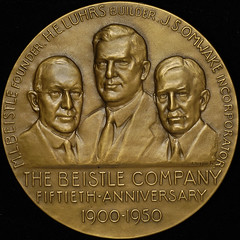
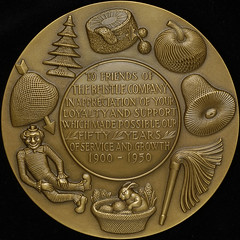
Beistle Company 50th Anniversary Medal
As already shown, the book is quite beefy from a numismatic research standpoint, but it is equally hefty as a catalog. Lange has carefully studied and compared thousands of coin albums from multiple manufacturers and plotted their evolution through multiple titles, editions and variants. A catalog number is assigned to each, and each entry lists the full title, publisher, publisher's stock item number, and other relevant information and commentary.
Far more than "just" a catalog, Lange's book is a sumptuous feast of hobby information, chock full of lavish, full-color illustrations. This is a very high-quality publication, and well worth the purchase price. It is one of the few numismatic books that is not only a reference, but worthy of curling up with in an easy chair for a pleasant evening's read.
The book is priced at $75, and buyers should include $10 for priority mail shipping. All books purchased directly from David will be signed, and personalized inscriptions are available upon request. Payment may be made by check made out to David W. Lange or via PayPal to LangeDW@msn.com. He may be contacted at POB 110022, Lakewood Ranch, FL 34211 or by email at langedw@msn.com. His website address is www.coincollectingboards.com .
To read the earlier E-Sylum articles, see:
NEW BOOK: COIN COLLECTING ALBUMS, VOLUME ONE
(www.coinbooks.org/esylum_v16n32a02.html)
NEW BOOK: THE NATIONAL COIN ALBUM AND RELATED PRODUCTS
(www.coinbooks.org/esylum_v16n41a04.html)
SELECTIONS FROM THE SKLOW LITERATURE SALE #21
301. Gouge, William M. A SHORT HISTORY OF PAPER-MONEY AND BANKING IN THE UNITED STATES. INCLUDING AN ACCOUNT OF PROVINCIAL AND CONTINENTAL PAPER-MONEY. TO WHICH IS PREFIXED. AN INQUIRY INTO THE PRINCIPLES OF THE SYSTEM, WITH CONSIDERATION OF ITS EFFECTS ON MORALS AND HAPPINESS. New-York: Published by B. & S. Collins. 1835 second edition. 42pp., 64pp. 8vo. tan cloth covers with the ornate plate of Nelson T. Thorson on front, original paper covers are bound in, spine label - Paper Money - Gouge 1835.
A most interesting work; basically in two parts as the title details; important for content on state banks being organized; also of interest is the fact that a second edition is not mentioned in Davis, or Clain-Stefanelli; this example is ex: libris of Nelson T. Thorson [past President of the ANA] with his ornate bookplate on front pastedown and ex: libris the Philamatic Center of Boys Town Nebraska with their bookplate below Thorson's and their stamp on the front endpaper, check out sheet on back pastedown; no library markings on internal pages; some foxing throughout; a scarce item, with a great pedigree; Clain-Stefanelli 13482 [1840 edition] Davis 442 [first edition]; Ex: Library [but nice]. (150.00)
1045. Daycius Galleries, Martin Nathaniel. ANNOUNCE: A PUBLIC AUCTION SALE - BOOKS AND CATALOGS ON COINS & SUNDRY ITEMS. Fort Worth, Texas. On Wednesday the First of April [1992] at 1204 Magnolia. Fort Worth, Texas 10:30 AM Sharp. 1 sheet 8.5 x 11 inches. Original duplicated typescript on pale blue paper. Once folded horizontally and with staple marks at top and bottom, mounted and matted in black.
The obverse of the flyer bears the title and address above, with the following text below - "Many 100's of lots, recently discovered, From a long deceased dealer. Old coin books. Many old catalogs in beautiful leathers, though a number marked up with prices and various names. Nice photos in a number. Lots of old records and invoices also. Several box lots of old coin envelopes, letters and so on. Large pile of old coin scales, a few going back to the 1820's. "TERMS OF SALE: CASH ONLY ALL ITEMS MUST BE PAID FOR AND REMOVED AT END OF THE SALE. M. N. Daycius, Auctioneer, Carrollton, Texas."
The flyer was folded, hand addressed in ink, with postage stamp affixed; this example being mounted, the mailing side is not visible, BUT, you can determine the name that is handwritten using a magnifying glass, it reads REMY BOURNE; the flyer was sent out by "unknown" person or persons;
An article appeared in The E-Sylum April 7, 2002 Vol. 5. #15 [as there was no E-Sylum in 1992] an excerpt of the editor's comments are offered here [with permission];
"A number of U.S. bibliophiles received a flyer postmarked Ft. Worth, TX, advertising an upcoming event run by an auctioneer named Martin Nathaniel Daycius. The auction consisted of an extensive numismatic literature library with items printed as early as 1820.
The address of the auction turned out to be of the B. Max Mehl building in Ft. Worth. Mehl's coin business was shut down decades ago, but to an expectant bibliophile, his library, if kept intact, could be a bonanza. Could it have been in storage all these years?
In every great con, the mark has to WANT to believe. And the flyer found a number of believers, some of whom went as far as booking flights to Texas prior to the sale date, Wednesday, April 1st. I checked my schedule and prices for flights too, but putting money down was too much of a leap of faith. Setting out to confirm the auction, I was frustrated by the lack of a contact phone number on the flyer (which you would think would be a big clue...)
There was no auctioneer named Daycius in the phone book. Ever resourceful, and knowing that auctioneers are generally licensed by the state, I called the licensing office and was told they had no record of the gentleman. 'But if he's holding an auction, we want to know about it. He'll be hearing from us.' Hmmm, clue number two.
Still undeterred, a few more phone calls and lots of southern hospitality later, I found myself talking to a clerk in a shoe store across the street from the Mehl Building. No luck. 'Oh, no,' she said, 'that place has been boarded up for years.' Clue the third?
I knew something was fishy, but it didn't dawn on me until later that evening. Sitting in night class I mentally pronounced the signature at the bottom of the flyer: M.N. Daycius. Men Daycius. Mendacious!......" -Editor {Wayne Homren};
This example is defect free and a great piece of numismatic literature lore; probably one of greatest numismatic April Fool's Day pranks ever executed; to this day no one has come forward to claim responsibility, BUT, many bibliophiles have their own idea of who sent the flyers! Fine+ (100.00)
David Sklow-Fine Numismatic Books
P.O. Box 6321
Colorado Springs, CO 80934
PH: 719-302-5686
FAX: 719-302-4933
Email: numismaticbooks@aol.com
Web Site: FineNumismaticBooks.com
To read the earlier E-Sylum article, see: SKLOW TO OFFER GRADY AND MOULTON LIBRARIES IN 2014 (www.coinbooks.org/esylum_v16n46a03.html)
EMPLOYMENT OPPORTUNITY!
Live and Work in Southern CaliforniaStack’s Bowers Galleries offers an important employment opportunity for the right person. We are seeking an experienced numismatist in the American series—coins, tokens, medals, and paper money—to work with our “dream team” of catalogers, building on the tradition of the Ford, Eliasberg, Bass, Cardinal, Norweb, Battle Born and other great collections.
If you can write in an authoritative and compelling manner with a high degree of accuracy, this may be just right for you! You will be working in Irvine, a modern community in dynamic Orange County, California—one of the finest areas to live. We offer generous benefits including medical and dental coverage, 401K plan, and more. Our offices are in our own modern, state-of-the art building with all amenities.
If you would like to be considered for this position please contact Q. David Bowers by mail or by email with your resumé, samples of your past writing (on numismatics or other subjects), and salary requirements: Mail to the attention of Q. David Bowers, PO Box 1804, Wolfeboro, NH 03894. Email to: Ckarstedt@stacksbowers.com
CHRISTOPHER EIMER ON THE AUGUSTIN DUPRE ARCHIVE
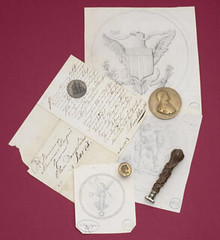 I have had a relatively brief opportunity of looking at the Augustin Dupre material at the London offices of Bonham’s, who are to sell the group in April in New York.
I have had a relatively brief opportunity of looking at the Augustin Dupre material at the London offices of Bonham’s, who are to sell the group in April in New York.
Fully understandable was the enthusiasm with which news of this event was greeted by the E-Sylum readership, but prior to the auction catalogue coming out, I believe that it would be best to keep expectations of its content to a realistic level, by immediately pointing out the absence of any Comitia Americana or other related material in silver, and by also remembering that much Dupre material is already accounted for in public collections, as well as in some important private gatherings.
That having been said, the group does contain a number of medallic sketches, which include those for the Daniel Morgan and Diplomatic medals (Adams, Comitia Americana, pp. 129-138 and 199-218). There are also uniface strikings of medals in tin or lead, which include those of Nathaniel Greene and Daniel Morgan medal (Adams, pp. 153-161, and 199-218).
The medals themselves include the 1790 oval silver ‘Pacte Federatif’ medal (sim. Hennin 165), a bronze example of the Benjamin Franklin eripuit coelo fulmen medal (Adams, pp. 174-79), and lead examples of the Diplomatic and Libertas Americana medals, but I believe these two to be later productions.
Amongst the sketched drafts for French coinage are ‘Union et Force’ and Paix et Abondance’ designs, the latter inscribed below ‘piece d’argent d’un france’.
As well as the material mentioned in the initial report in the E-Sylum, the archive also includes uniface strikings and miscellaneous trials of seals and jetons
Of a more personal nature is an interesting gilt-plaster impression, 70 mm. in diameter and dated 1787, which seems to constitute an apprentice’s presentation piece, inscribed as it is from Dupre’s pupil ‘Lambert’, the legend reading ‘Hommage De Tendresse et de Reconnaissance’. Also included in the archive is Dupre’s Legion of Honour award together with a lock of his hair, contained in a frame and accordingly inscribed.
As E-Sylum readers may realize, a number of Dupre-related items have been added to the archive over the years, and I understand from John Millinsted, the head of Coins and Medals at Bonhams, London, that the entire group is to be sold as one lot.
To read the earlier E-Sylum article, see: BONHAM'S TO SELL AUGUSTIN DUPRÉ ARCHIVE (www.coinbooks.org/esylum_v17n02a07.html)
NOTES FROM E-SYLUM READERS: JANUARY 26, 2014
On the Non-Collectible Designation David Gladfelter writes:
After Walter Breen abandoned William Sheldon’s NC designations in his posthumous Walter Breen’s Encyclopedia of United States Large Cents, reintroducing them would seem to be a step in the wrong direction. The term hasn’t caught on anywhere else. If looking at an unfilled hole in a coin album is too annoying, one could always insert little blue “RARE” plugs the way Whitman did for the 1913 date in its Liberty Head nickel holders.
To read the earlier E-Sylum article, see: "NON-COLLECTIBLE" CIVIL WAR TOKEN DESIGNATION SOUGHT (www.coinbooks.org/esylum_v17n03a20.html)
On the "Hundred Million Billion Pengo note Steve D'Ippolito writes:
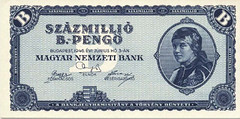 It's actually worse than that. The Hungarians used the old British nomenclature for large numbers, known as the long scale. In that system, a "billion" is a million million (not a thousand million), a 1 with twelve zeros after it, what we call a trillion in the US. (It appears that the UK uses our "short scale" now.) The long scale uses the word "milliard" for a thousand million (what the short scale calls a billion). Apparently it is actually the case that a "thousand billion" (i.e., 1 with fifteen zeros after it, a thousand million million, what we call a quadrillion) is known as a "billiard," which is pretty amusing when you think about it.
It's actually worse than that. The Hungarians used the old British nomenclature for large numbers, known as the long scale. In that system, a "billion" is a million million (not a thousand million), a 1 with twelve zeros after it, what we call a trillion in the US. (It appears that the UK uses our "short scale" now.) The long scale uses the word "milliard" for a thousand million (what the short scale calls a billion). Apparently it is actually the case that a "thousand billion" (i.e., 1 with fifteen zeros after it, a thousand million million, what we call a quadrillion) is known as a "billiard," which is pretty amusing when you think about it.
So this "hundred million billion pengo" note, was, in short scale a hundred quintillion (1 with twenty zeros after it) pengos. If I recall correctly there was a "Milliard B-Pengo" note as well (21 zeros) that was printed but not issued. Eventually the Hungarians lopped twenty nine zeros off their money and issued the forint at 1 forint = 400,000 quadrillion (long scale; 400 octillion on the short scale) pengos. All of the pengos in circulation, at that point, were worth less one thousandth of one of the new forints.
To read the earlier E-Sylum article, see: NOTES FROM E-SYLUM READERS: JANUARY 19, 2014 : Howard Berlin on Hyperinflation Banknotes (www.coinbooks.org/esylum_v17n03a11.html)
Telford Hotel's 'Bank of Buckatree' Notes
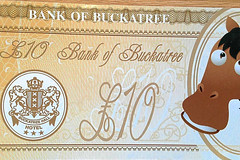 Visitors to the Buckatree Hall Hotel, at the foot of The Wrekin in Telford, will be handing out notes from the Bank of Buckatree to spend in the hotel from this month.
Visitors to the Buckatree Hall Hotel, at the foot of The Wrekin in Telford, will be handing out notes from the Bank of Buckatree to spend in the hotel from this month.
The Monopoly-style cash feature a horse in place of the Queen in recognition of the owner Grant Moon, who is six times holder of the World Champion Blacksmith title.
The novel idea which accompanies a loyalty card scheme follows a £1 million refurbishment project at the 62-bedroom hotel.
General manager Wayne Jenson said: “The Bank of Buckatree is a bit of fun to say we have our own currency, but it sets us apart from chain hotels across the county. It’s the personal touch that counts.”
To read the complete article, see: Telford hotel prints banknotes as thank you to loyal patrons (www.shropshirestar.com/news/2014/01/20/telford-hotel-prints-banknotes-as-thank-you-to-loyal-patrons-2/)
A Camp Douglas Prisoner Regarding the Camp Douglas sutler appointment document discussed last week, Harold Levi writes:
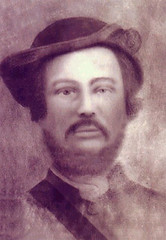 My ancestor, Jasper Newton Levi, Company H, 2nd (Ashby's) Tennessee Cavalry, was captured at the Battle of Murfreesboro [Tenn.] on 31 December 1862 after being wounded. He was taken to Camp Douglas, Illinois and paroled 30 March 1863. He was received at City Point, Virginia 4 April 1863. It seems Newt did not meet Mr. Burr since his appointment did not take effect until 30 March 1864.
My ancestor, Jasper Newton Levi, Company H, 2nd (Ashby's) Tennessee Cavalry, was captured at the Battle of Murfreesboro [Tenn.] on 31 December 1862 after being wounded. He was taken to Camp Douglas, Illinois and paroled 30 March 1863. He was received at City Point, Virginia 4 April 1863. It seems Newt did not meet Mr. Burr since his appointment did not take effect until 30 March 1864.
This is an interesting document. I have never seen a sutler appointment order before. I assume this is a rare document. It sold on eBay for $202.50.
To read the earlier E-Sylum article, see: LUMAN BURR CIVIL WAR SUTLER APPOINTMENT DOCUMENT (www.coinbooks.org/esylum_v17n03a13.html)
TALE OF THE TAPE: PITTMAN, BREEN AND THE TAXAY BOOK BLURB
Fred Michaelson writes:
I just received the January 2014 issue of "The Numismatist" and read a great article by George Kolbe, "The Tale of the Tape". He writes of a publisher's problem with a dust jacket.
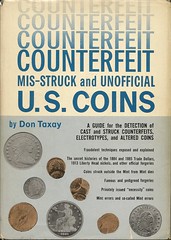 In Spring of 1963, Don Taxay’s Counterfeit, Mis-Struck, and Unofficial U.S. Coins, featuring the imprimatur of a respected New York publishing firm, created something of a numismatic sensation. Counterfeit coins were proliferating at the time and Taxay’s book was the first in-depth American work providing—to quote its sub-title—“a guide for the detection of cast and struck counterfeits, electrotypes, and altered coins.” The April 1963 first printing was followed three months later by a second printing; a third printing followed in 1975 and a fourth printing came off the press in 1976.
In Spring of 1963, Don Taxay’s Counterfeit, Mis-Struck, and Unofficial U.S. Coins, featuring the imprimatur of a respected New York publishing firm, created something of a numismatic sensation. Counterfeit coins were proliferating at the time and Taxay’s book was the first in-depth American work providing—to quote its sub-title—“a guide for the detection of cast and struck counterfeits, electrotypes, and altered coins.” The April 1963 first printing was followed three months later by a second printing; a third printing followed in 1975 and a fourth printing came off the press in 1976.
John J. Ford, Jr. wrote the introduction and the four printings of the book feature endorsements attributed to Eric P. Newman, Walter Breen, and Dr. George Fuld, located on the back of the dust jackets of the first two hard cover issues and on the rear covers of the last two soft cover printings. The text appears to be identical throughout but, on the first printing, a label has been affixed at the base ascribing the quotation above it to:
—DR. GEORGE FULD, Past-President, The Token and Medal Society, recognized authority on U.S. numismatic ephemera and oddments.
This label, though rather unusual, has been little commented upon over the years. If the dust jacket is held up to a strong source of light, the printing under the label dimly reveals itself, though the adhesive utilized makes the printed slip itself quite difficult to remove.
The label is impervious to water—denatured alcohol and toluene barely affect it—and it is removable only slowly with the good stuff: acetone. Allowing time for head-clearing after inhaling this witches brew of noxious chemicals, the covered-up text reveals itself:
—JOHN JAY PITTMAN, Member, Board of Governors, American Numismatic Society, one of foremost numismatic authorities in the United States.
One might surmise that the incorrect affiliation (American Numismatic Society, instead of Association) and grammatical omission (“the” missing between “of” and “foremost”) account for the label, but neither explains the name change. Further, the text of both blurbs is identical. How could this be? Thus begins the tale of the tape.
Fred Michaelson adds:
In short, John Jay Pittman refused to have his quote on the same dust jacket with that of Walter Breen (because of his dislike of Breen). It was an intense little drama, and fun to read. I don't know whose idea it was to place Pittman's photograph next to Breen's on the first page of the article---maybe it was just happenstance---but I'm still chuckling at the delicious irony of it.

DAVID PROSKEY AND THE PROSKEY BROS. CARDBOARD CHITS
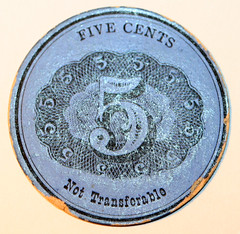
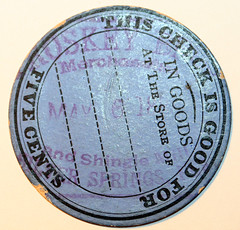
The Internet auction title described the item being offered for sale as “Proskey Bros. Cardboard Chit Silver Springs, Maryland Shingle Mill.” In the description section there was no additional information, or any basis for the attribution. But, I knew immediately that the token wasn’t from Maryland. Silver Springs is a suburb of Washington, D.C., and I doubt that there were ever any shingle mills in that area.
I was familiar with the token, even though I had never actually seen one. I first learned of it when a pair of them -- a five cents and a twenty-five cents denomination -- was listed in the 1985 Bowers and Merena sale of the Russell B. Patterson collection. I don’t recall whether I placed a bid, but if so I wasn’t the winner of the lot.
Later, as Lot 5740 of the November, 2007 Smythe & Co. sale, two denominations ($1.00 and $5.00) of rectangular cardboard punch cards from the Proskey Brothers Store of Silver Springs, Florida were offered for sale. They are undated, but probably postdate the round cardboard tokens.
C. R. Clark’s reference, Florida Tokens, lists the round cardboard tokens with the following note: “the handstamp used to print information about the issuer was too large for the tokens. By combining information stamped on the 5 and 25, the 5 appears to read as follows: PROSKEY BROS. / MERCHANDISE / APR. 9 – 1886 / AND SHINGLE MILL / SILVER SPRINGS, FLA.” Clark gives the size as 35mm; my token is definitely 36mm.
The exact obverse inscription on my recently acquired token (taking into account the fact that not all of the rubber stamped lettering is readable) is probably THIS CHECK IS GOOD FOR / IN GOODS / AT THE STORE OF / PROSKEY BROS. / MERCHANDISE / MAY 6 1886 / AND SHINGLE MILL / SILVER SPRINGS, FLA. (the last five lines are rubber-stamped) / FIVE CENTS. The reverse is FIVE CENTS / 5 / NOT TRANSFERABLE.
My token is blue cardboard, while the twenty-five cents denomination listed by Clark is yellow. The last digit of the year is not readable on my piece, but I assume it is a 6. The month and day are definitely May and 6; Clark gives the date as April 9, which I don’t question, although I find it odd that the company would have had two different dates of rubber stamps made.
The famous coin dealer, David Proskey, who died in 1929, was part of the Proskey Brothers family. He evidently operated his coin business from the lumber company’s office. I found an interesting piece of correspondence on the PGCS website, dated June 4, 1884 from David, who was “writing from the office of Proskey Brothers, manufacturers of yellow pine lumber and cypress shingles, and general storekeepers, 4448 River Street, Patterson, New Jersey.” It was addressed to T. Harrison Garrett, and Proskey included rubbings of “four rare copper colonials recently dug up on a farm in this state. Each is for sale at the price marked, with a full guarantee of genuineness.”
HIDDEN IMAGES: THE RAT HALFPENNY
Your recent articles in The E-Sylum about hidden pictures within others, e.g. the "Devil's Head" photograph of Elizabeth II, prompts me to enquire how many of your readers have heard of the "Rat Halfpenny" and other similar British coins of George II.
It would appear that the engraver of the time, John Tanner, and/or possibly his predecessor John Croker, was possessed of what today would be colloquially described as a rather wicked sense of humour. If you look closely at the folds of the clothing which cover Britannia's right leg on a decent condition young head George II halfpenny, it would appear that she has a rat crawling up it; whilst if you turn the piece over, the head of a cat may be discerned atop the kings head, with its eye formed by the top curl of hair and its ears by the upmost two leaves of the wreath. Nor were our numismatic miscreants less active on the Old Head pieces, where certain gargoyles can sometimes be discerned in the lower reaches of the hairpiece on the silver.
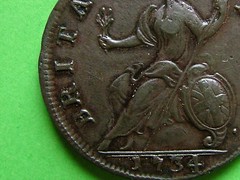
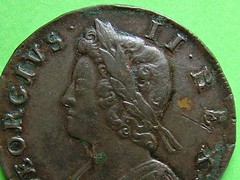
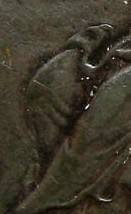
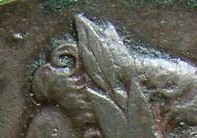
How well these devices were appreciated by the public of the time I am not sure, but possibly it may be the reason why Tanner's surname became adopted for posterity as the slang term for the sixpence.
Robert Walpole's skilful handling of the South Sea Bubble had won him a similar honour a few years previously in respect of the shilling, after the common 1723 SSC coin of that value into which the South Sea Company's confiscated bullion assets were predominantly converted; as is well known, the diminutive of Robert is Bob. Maybe Tanner just happened to be the right man in the right place at the right time when the public were looking to name the sixpence.
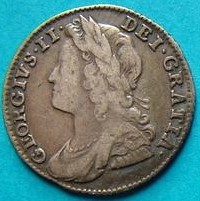
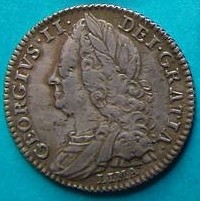
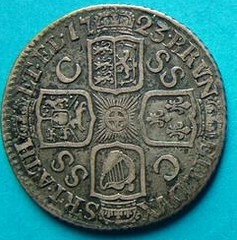
1723 SSC reverse
To read the earlier E-Sylum article, see: YOUSUF KARSH AND THE "DEVIL'S HEAD" PHOTO OF ELIZABETH II (www.coinbooks.org/esylum_v17n03a23.html)
MEDALS OF THE LITERARY SOCIETY OF KING’S COLLEGE

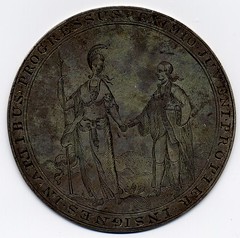
The Gouverneur Morris specimen
Vicken Yegparian, Vice President of Stack’s Bowers Galleries, was the distinguished guest speaker for the nine hundredth meeting of the New Jersey Numismatic Society (NJNS) at the Madison Public Library in Madison, New Jersey, on January 20, 2014. The New Jersey Numismatic Society was founded in 1933.
Ray Williams, former President of C-4, introduced the speaker, who is well known to NJNS members. Vicken and John Kraljevich were star pupils as young numismatists in the group. Yegparian remembered that as a teenager, he enjoyed attending NJNS meetings and going out to dinner afterward with more seasoned numismatists. Vicken is grateful for the mentoring and support he received from the older members of the Society.
Yegparian’s topic was, “The Medals of the Literary Society of King’s College in New York, 1767-1771: The Unheralded First Civilian Medals Produced in America.” Vicken gave an engaging PowerPoint presentation featuring images of medals and archival documents at the well-attended meeting. He explained that in 2001, Stack’s was responsible for a hand-engraved silver medal of King’s College, the colonial precursor of Columbia University.
Although the medal was little known or understood by numismatists at the time, Vicken’s research in primary source documents at the New-York Historical Society and a study of the three surviving King’s College medals have increased our knowledge of the items. Vicken ranked the three specimens alongside the Betts medals in importance. He also pointed out that in contrast to the Betts medals, which were military or strategic in nature, these items were the first purely civilian medals produced in the colonies. As a Columbia alumnus, Vicken had a particular interest in researching these works of art, the third earliest colonial medals.
Refreshments were served to celebrate the Society’s historic milestone. During the photo op, NJNS President Dave Bailey and Ray Williams presented Vicken with a beautiful medal designed for the 900th meeting of the NJNS. Vicken also was offered an honorarium, but he politely refused it, requesting that the funds be given to another young numismatist to be helped as much as he was by the NJNS.
ATLANTA ANA EXHIBITS: EVENT OR ROUTINE?
The rich numismatic history of Georgia and the South will be on display when the National Money Show comes to the Cobb Galleria Centre in Atlanta, Ga., Feb. 27-March 1, 2014. On exhibit in the ANA’s signature Museum Showcase, featuring rarities from the Edward C. Rochette Money Museum in Colorado Springs and exclusive private collections, will be a collection of Georgia Colonial paper money from its beginnings in 1735 to the end of the American Revolution. Also on display will be gold coins from the U.S. Branch Mints in Dahlonega, Ga., and Charlotte, N.C., which operated from 1838 through 1861.
- Gold! The Coins of Georgia and North Carolina
- Colonial Paper Money of Georgia
- Confederate Currency
- 1792 Half Disme
- 1804 Dollar, Idler/Bebee Class III
- 1913 Liberty Head V Nickel, McDermott/Bebee
The Southern gold, Georgia colonials and Confederate currency exhibits are a great tie-in with the local area, and I expect they'll be well received. The U.S. rarities are perennial headline items, but I've heard from some readers that they're getting tired of hearing about the 1913 Nickel. Perhaps it's time for numismatists to take a cue from the Disney marketing playbook; hold these items back for a period of time to avoid market oversaturation. Every seven to ten years Disney might rerelease a classic film like Snow White. When it happens, it's a notable event, and there is a clear urgency for anyone with an interest to go see it before it disappears from the market again. The first-time-in-decades display of all five 1913 Liberty Nickels was a newsworthy event; trotting out one of them for yet another viewing seems routine. What do readers think? -Editor
For more information on the show, see: www.nationalmoneyshow.com
WAYNE'S NUMISMATIC DIARY: JANUARY 26, 2014
Tuesday, January 14, 2014 was the monthly meeting of my Northern Virginia numismatic social group, Nummis Nova. I'm behind the times in writing up my diary, but here's an abbreviated version.
Wayne Herndon was our host, and we held the event, fittingly, in Herndon, VA. We gathered at the Bertucci's restaurant. After a slight mixup we were seated in the party room, which had both ample space and lighting, perfect for a group like ours.
I had brought along some recent issues of ANS Magazine for Chris Neuzil to review. We were trying to locate a reference he'd seen earlier, but no such luck. Perhaps another time. I'd also brought along my numismatic postcard and stereo card collection. I'd pulled it out to show Tom Kays, and even though he couldn't attend this month, I brought it along anyway for fun. I'll bring them back next time.
I thanked Wayne Herndon for calling me from Florida with the news of John Burns' death. That was a topic of conversation among the attendees, most of whom knew John from the various coin shows he attended.
Dave Schenkman and Gene Brandenburg were running late. Without Gene's expertise I was lost in picking a wine, but I took a shot on a glass of Merlot. I was pleased to see the waiter bring Gene's wine order, which included a bottle of the same Merlot. Gene kept topping off my glass the rest of the evening. I rarely imbibe outside of these monthly nights out, and really enjoyed it.
Steve Bishop passed around a group of beautifully toned Morgan dollars while I passed around my postcards. Eric Schena had a number of interesting ephemera items. He provided images for The E-Sylum and the following commentary:
To go with the theme of recent acquisitions, I brought some documents that came with a two drawer Ingle System register that I had just bought from a gentleman in Orange, Virginia.
The register in itself is a fantastic find and in great shape, but most importantly, the two drawers were stuffed with papers from the original store where the register was used, the William H. Young store in Clover Lick, Pocahontas County, WV.
 Young ordered his register sometime in 1917 and was fortunately a bit of a packrat for papers. The register's drawers contained a Dayton Stencil Works token catalog (it even had the order form and return envelope) and an Ingle System confidential price list dated 1 Jan 1916, something that appears to have never been seen before.
Young ordered his register sometime in 1917 and was fortunately a bit of a packrat for papers. The register's drawers contained a Dayton Stencil Works token catalog (it even had the order form and return envelope) and an Ingle System confidential price list dated 1 Jan 1916, something that appears to have never been seen before.
It also included some blank forms/receipts that were ordered from Ingle. You'll see on the price list a special order "form 22" for payroll deductions - there's a pad of those with the register, as well as a pad of "form 23", which apparently came with each register ordered from Ingle. There were also cash receipts, as well, plus a pile of deposit postcards from the First National Bank of Marlinton.
I also brought one of the payroll deduction forms that was partially filled out and it was to indicate that Raines Lumber Co. was authorized to deduct $10 pay to pay W. H. Young. I am in the process of doing some more research and will be writing an article for the National Scrip Collectors Association's journal, Scrip Talk. The register was a bit of a time capsule and I hope to do it justice.
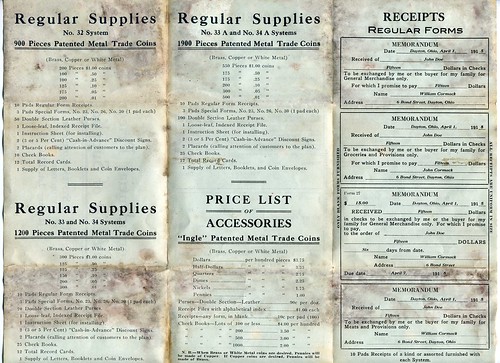
Ingle System Supply Price List
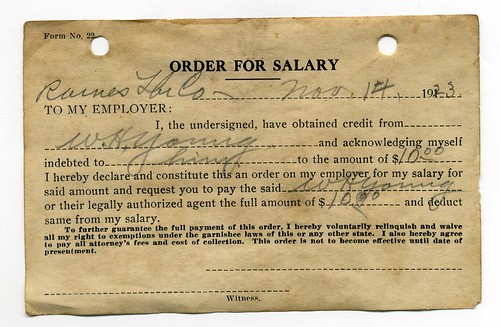
Early payday loan business?
I congratulated Eric on his great purchase. My favorite item was the Dayton Stencil Works token catalog. What a great piece of ephemera, and perfect for researching old tokens!
I chatted briefly with nearly everyone before I had to rush off to get home before my wife took our oldest son to his basketball game. Others present included Jon Radel, Roger Burdette, Joe Levine, Aaron Packard, and Julian Leidman.
These meetings are always fun. When I founded the group I modelled it after The Sphinx Society, founded in Pittsburgh in 1960. I had been a member until I moved to Virginia. This week I found a great present in the mail from E-Sylum reader Duane Feisel. It was an undated Sphinx membership roster and meeting notice. Well it had a date, but no year: Sunday, September 11th, 1pm at the Mountain View Hotel, Greensburg.
The members at the time were Ray Byrne, Joe Breyer, Prosper DeVos, Duane Feisel, Ithamar B. Lando, Gordon Dodrill, Ed Szypulski, Dr. Robert J. Hudson, George Kiefer, Bob Porter, Emerson Smith, Philip Williams, and Howard Gibbs.
I met Dodrill, Porter and Smith. Byrne and Feisel had moved away from Pittsburgh by the time I became active in the local clubs. If E-Sylum readers have stories to share about any of the Sphinx members, I'd be happy to hear them. That's all for this time.
THE BOOK BAZARRE
MINT TESTING COPPER-PLATED ZINC FOR 5-CENT COIN
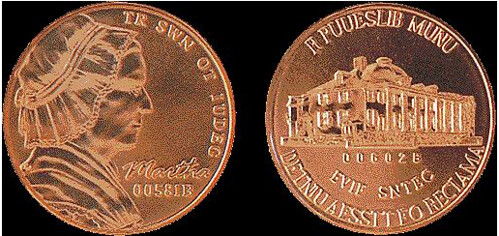
The United States Mint has been striking experimental Jefferson 5-cent coins in copper-plated zinc.
In efforts to save money by finding suitable alternative compositions for circulating coinage, the U.S. Mint is considering, among its options, changing the 5-cent coin from its current copper-nickel alloy to the same composition as the current Lincoln cent.
At 21.21 millimeters in diameter and 5 grams in weight, the 5-cent coin is larger and heavier than the copper-plated zinc cent. The cent is 19 millimeters in diameter and weighs 2.5 grams.
The experimental copper-plated zinc strikes the Mint has executed at the Philadelphia Mint for the 5-cent coin weigh 4.06 grams and maintain the coin’s current diameter, according to U.S. Mint officials.
U.S. Mint spokesman Michael White said Jan. 23 that the copper-plated zinc planchets for the 5-cent experimental strikes were supplied by Jarden Zinc Products of Greeneville, Tenn.
The copper-plated zinc planchets for the 5-cent denomination experimental strikes are being struck with what the U.S. Mint refers to as “nonsense dies” to test the alloy. The dies bear an obverse portrait of Martha Washington facing right, and the reverse, a rendition of the Washington home, Mount Vernon, in Virginia. The Mint has used variations of these two designs for decades when testing new compositions for circulating coinage.
The Philadelphia Mint is expected to continue experimental strike production in February.
To read the complete article, see: Mint testing copper-plated zinc for 5-cent coin (www.coinworld.com/articles/mint-testing-copper-plated-zinc-for-5-coin)
MORE ON THE NEW ENGLAND MEDALS BOOK SERIES
While many of the items listed in Bob Heath’s catalogs were from his own collections, we in New England were proud to let him photograph and list items from our own collections. In the late 90s, we formed a club called The New England Exonumia Society (NEES), with most of the meetings at Bob’s house. Members of the club would bring new stuff to show off and catalog. Even after NEES died, several of us would inform Bob of new discoveries and would bring them to a show where Bob would do his magic with them.
He had a specific gravity rig to determine composition if it was ever in doubt. As an industrial photographer, he had created a small portable photo stand with lights and a mount for his camera, originally film, later digital. He was in the process of converting all photographs in his catalogs to digital with razor sharp images when he passed on, a project he had almost completed. He was also gathering information on Massachusetts Bay Tercentenary medals, to update Shepard Pond’s catalog from the 1930s, a project that will probably never get finished.
The New England series is one of the nicest sets of medals in the country, mostly high relief, with excellent artwork. Most of them were executed by either the Robbins Company of Attleboro, MA, or V.H. Blackinton of Attleboro Falls, MA. My own entry into medal collecting was through the New Hampshire series, and I have rarely strayed into the other New England states with a few exceptions.
 Missing from Dick’s list of Heath catalogs is the seventh volume in the series – N.E.N.A. Conference & Convention Medals including Transportation Tokens and Related Exonumia. Bob was the Medals Chairman when I was NENA President, and he did wonderful work soliciting designs from association members, working with the manufacturer to produce an outstanding medal year after year, and distributing the medals to members and other collectors.
Missing from Dick’s list of Heath catalogs is the seventh volume in the series – N.E.N.A. Conference & Convention Medals including Transportation Tokens and Related Exonumia. Bob was the Medals Chairman when I was NENA President, and he did wonderful work soliciting designs from association members, working with the manufacturer to produce an outstanding medal year after year, and distributing the medals to members and other collectors.
I am the current editor of the NENA catalog and have just completed an update including the 2013 medal. I will soon be reformatting the whole catalog into a web-based product which will be available through the soon-to-be-opened NENA store at the website www.nenacoin.org. I will make the announcement when it is ready.
Most of the catalogs that were given to new editors were turned over to the Kittredge Numismatic Foundation. The original idea was that each of the editors would update their catalogs and KNF would publish them. That has not yet happened. Catalogs for CT, RI, MA and NENA (no Oxford Comma there) were included in that turnover. NH is still active, I am unsure what happened to VT, and we have never heard from the ME guy. Maybe we can learn some more information as a result of this thread.
To read the earlier E-Sylum articles, see:
ROBERT HEATH'S NEW ENGLAND MEDAL CATALOGS
(www.coinbooks.org/esylum_v17n01a20.html)
NOTES FROM E-SYLUM READERS: JANUARY 19, 2014 : More on Heath's Medal Catalogs
(www.coinbooks.org/esylum_v17n03a11.html)
SAINT-GAUDENS DIANA STATUE RESTORATION

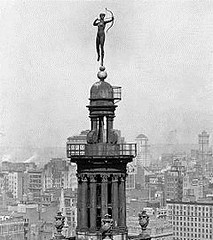
A masterpiece greeting visitors at the Philadelphia Museum of Art, the statue of Diana, is getting a coat of gold to restore the figure to her Gilded Age beauty.
The 13-foot tall work by Augustus Saint-Gaudens that commands the museum’s Great Stair Hall has been holding watch there since 1932.
The nude Diana was originally mounted atop the tower of Madison Square Garden in New York City, in 1893, as a weathervane. The original gold coating wore off due to its exposure to the elements.
Her current gray-green surface is a copper underlayer, but thanks to a gift from the Bank of America, the regilding process will give her a gold leaf coat, restoring the graceful Diana to her original splendor as she balances on her left tiptoe. Diana is the most famous work of Saint-Gaudens, in part because of the scandal surrounding it that was later described in E.L. Doctorow’s novel, Ragtime.
“Augustus Saint-Gaudens is, in my opinion, the greatest sculptor in the US working in the late 19th and early 20th centuries, and one of the great modern sculptors of all time,” museum CEO Timothy Rub tells KYW Newsradio.
The four-month project will be well documented. Each step of the conservation process will be monitored by a webcam, so you can follow Diana’s restoration on the museum’s web site.
To read the complete article, see: Philadelphia Art Museum Readies Diana For A New Coat — Of Gold (philadelphia.cbslocal.com/2013/06/20/philadelphia-art-museum-readies-diana-for-a-new-coat-of-gold/)
To visit the museum's Diana restoration web page, see: Gilding Diana (www.philamuseum.org/conservation/21.html)
THE BOOK BAZARRE
MORE ON NUMISMATIC POSTCARDS
David Gladfelter writes:
Don Kolkman’s postcard with embossed Mexican coins is a Hugo Semmler product, although it lacks Semmler’s name or initials as well as the exchange rate table. The card was probably printed for a jobber to distribute. No jobber’s name appears either, although Semmler is known to have produced cambist postcards for at least nine jobbers throughout the world located in Europe, South Africa and South America.
I have the same card with a 6 March 1908 postmark, also an unpostmarked variant (different flag) with a jobber’s initials J.C.S. in the lower left corner (see illustration). A later card with the same Mexican face design has the imprint of Max Heimbrecht on the back. Heimbrecht was Semmler’s business successor circa 1912.
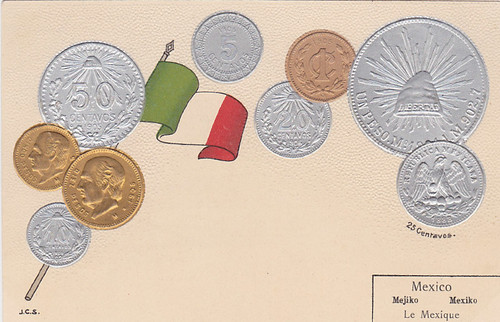
Semmler’s H.S.M. imprint appears on a card (see accompanying illustration) showing an earlier series of Mexican coins, the latest of which is dated 1904. When new coins came out the following year, Semmler changed the design.

Frank Draskovic writes:
My thanks to our editor for confirming that my short submission about the H.S.M. set of Coin Postcards originally contained no reference to the Blumel album, the comments referring only to my own, ca. 1905, album. And of course the illustration of the “Fortuna” seller label would have left no doubt as to the original source of the postcard set.
As to the publisher’s initials and my presumption of “H.S.M.” being for Hermann Sonntag of Munich, I found that attribution at an excellent and highly recommended website published by The Metropolitan Postcard Club of New York City, under their “Guide To Publisher’s Initials”, wherein they explain in part,
“While some publishers used initials exclusively to identify themselves, others alternated between their full name or logo without any consistency. Due to the nature of initials there are multiple publishers who used the same letters so this method of identification is by no means foolproof. It may also be difficult to determine if the initials belong to a publisher or to a printer, as the same company could function as one or the other or both at the same time. It may be noted that on many European cards the abbreviation may incorporate the name of the publisher’s town so they don’t exactly match the company name. Many times the full written name of the town may follow the initials, which is often confused with part of a person's name. Most initials will appear on the back of a card but sometimes they might be found on the front. In this case it is important not to confuse them with the initials of the artist who might have illustrated the card.”
One of Mr. Gladfelter’s illustrated German cards is clearly from publisher Hugo Semmler of Magdeburg, and it is more than likely that the H.S.M. shown on his second illustrated German card represents the same firm. I just now checked my set again (I’ve spent more time with these in the last two weeks than the previous quarter century!) and find that those with the “H.S.M.” logo, printed on the front on 40 of 46 cards, are all divided backs (DB) with a stamp box at upper right that contains “Printed in Bavaria”, i.e. Munich, whereas Magdeburg is in Saxony.
But of course publisher Semmler in Magdeburg could have had some of his run made in Munich, Bavaria or maybe he moved his business. Interestingly only one postcard, from my album set of 46, shows a place of manufacture other than Bavaria. The Tunis card has, within the stamp box, “Printed at works in Saxony” (what fun!…kind of like mintmarks!), yet it is one of the above mentioned six without “H.S.M.” or other maker logo (Uh-oh, now we have die varieties too).
Here is my German card, (different than both of Mr. Gladfelter’s and with a 1905 date on the Half-Mark that I previously missed) and also the ever popular USA card. Note that on all three German cards, the coin above the denomination “3 Mark”, is not a Three Mark coin at all, rather the reverse of a Vereinstaler (Union Taler) of 1867, perhaps the Prussian version of the Munzverein (coinage union) issues that began in 1857 and lasted until the advent of the German Empire in 1871, with its new Mark denomination coinage. After unification, the Vereinstalers circulated with a value of 3 Marks, and as these three postcards were produced prior to the issuance of 3 Mark denominated coins in 1908, the Vereinstaler shows with a value of 3 Mark. The latest coin date on the US card is 1902 seen on the half dollar and gold $20. Both say “Printed in Bavaria” within the reverse stamp box.
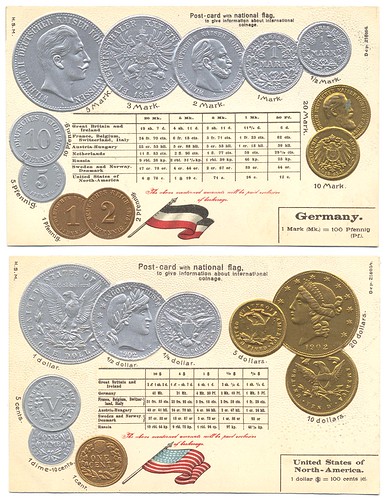
Kudos to cherry picker Don for finding the USA card. Perhaps others will also consider collecting these fascinating examples of numismatic ephemera!"
To visit the Metropolitan Postcard Club of New York site, see: www.metropostcard.com
To read the Club's Guide, see: Guide to Publisher’s Initials (www.metropostcard.com/guideinitials.html)
To read the earlier E-Sylum article, see: MORE ON NUMISMATIC POSTCARDS AND ALBUMS (www.coinbooks.org/esylum_v17n03a12.html)
COIN CIGARETTE CARDS
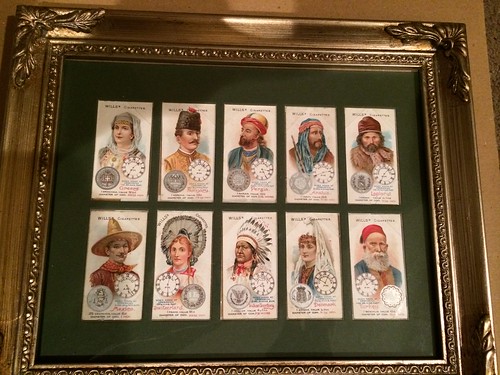
As always, a fascinating "issue" to read! Almost good enough to get over not be able to hold it in your hands and turn the pages!
The coin postcards were interesting. Last year while I was in London I picked up a set of something close, but a bit different -- a set of coin-related cigarette cards. The Brits (who still seem to smoke far more than their US counterparts) were ahead of their time in marketing. What the US did with baseball cards they did with cigarette cards. The leading brands would put one card in each pack of their cigarettes, and people found out that it was fun to collect something (and bought more smokes as a result). There were a wide variety of sets issues, usually 50 cards to a set. Movie start, athletes, flowers, birds, architecture from across the world -- pretty much anything that had enough things available to put out a set of cards was pressed into service!
Unfortunately they didn't do a set of "rarest coins of the world" -- think how valuable that would be today! But they did come close, and the Wills' Cigarette Company issued a set of 50 cards in 1908 called "Time and Money." Each card showed a representative of a country, in native dress, with a coin showing the main unit of currency there and a clock showing its time in relation to England (of course).
I've attached a picture of the framed set that includes the United States -- apparently the average Yank in 1908 was not that interesting, so they chose to go with an Indian chief -- which would have been in short supply in most parts of the country at the time. NOT in short supply would be the Morgan dollar used to illustrate our currency (then or now).
I was surprised to find full sets of various cards not that expensive. I brought back a few sets for my mother (one of flowers and a framed set of 5 cards depicting trains that were in their original cigarette company frame), and bought this and another set for me -- the coin one was the most expensive at 25 Pounds, the rest were 10-20 Pounds. Like baseball cards, these were highly collected, but today don't seem to be very popular -- though they look really great mounted and framed!
To read the earlier E-Sylum article, see: MORE ON NUMISMATIC POSTCARDS AND ALBUMS (www.coinbooks.org/esylum_v17n03a12.html)
URSULA KAMPMANN: VISITING THE NEW YORK INTERNATIONAL
American coin fairs really do not have much in common with the fairs we get to attend in Europe. American coin fairs are never just about buying and selling but about providing various attractions for collectors and dealers. There are plenty of things to do for you at an American fair: talks, society get-togethers, auctions and exhibitions. What’s more, the New York International has developed into the most luxurious edition of all the fairs in the past decades – and not only since the event has been moved to the Waldorf Astoria.
The lobby truly is the heart of the house, especially because of the Wi-Fi which saves you the exorbitant price you would otherwise pay for internet access in your room. So visitors of the New York International make themselves at home in the lobby’s comfortable chairs from morning to night to check their emails. If you forgot to make plans for dinner at the fair, you would simply come downstairs shortly before 7pm. That’s when everybody meets in the lobby – and with a little patience you would always find someone or other you knew.
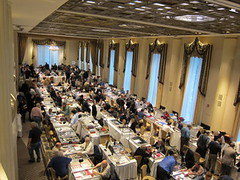 The Starlight Roof is the room where most of the action takes place; “starlight” because years ago, the glass roof which covered the hall offered a view of the night sky. By now, electric light has eclipsed the starlight and the Waldorf Astoria’s former glass roof has been substituted by a ceiling when another five stories were added to the building. Despite all that, the hall has kept some of the splendour from its heyday. Since the 50s, the sons and daughters of the rich and famous celebrate themselves at the debutant ball which is held in this room. Daughters of presidents, of the Rockefellers’ and Vanderbilts’, of the House of Habsburg and Bismarck come out here for the first time.
The Starlight Roof is the room where most of the action takes place; “starlight” because years ago, the glass roof which covered the hall offered a view of the night sky. By now, electric light has eclipsed the starlight and the Waldorf Astoria’s former glass roof has been substituted by a ceiling when another five stories were added to the building. Despite all that, the hall has kept some of the splendour from its heyday. Since the 50s, the sons and daughters of the rich and famous celebrate themselves at the debutant ball which is held in this room. Daughters of presidents, of the Rockefellers’ and Vanderbilts’, of the House of Habsburg and Bismarck come out here for the first time.
The exhibitors were very international. Apart from the American companies, which – unsurprisingly – made up more than half of the participants, the most active and renowned coin dealers from all over the world were present.
At the New York International, six major international auction houses hold their auctions: Heritage, CNG, Stacks-Bowers-Ponterio, Gemini and Kolbe & Fanning, not to forget the New York Sale organized by Baldwin, Dmitry Markov and M&M Numismatics. Every year yields new record prives. I won’t go into detail here as you can read all about it in the follow-up reports on the auctions.
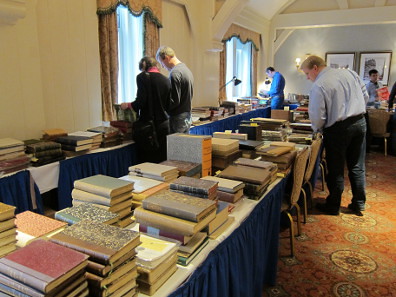
The viewing room of the Kolbe & Fanning auction
I recommend a visit to anyone who is interested in ancient and world coins. You are going to discover a whole new world of numismatics. A world which even provides chairs at the dealers’ tables so that dealers and collectors can have long conversations. A world, where famous collectors, whose collections have been published as standard works, mingle with completely “ordinary” collectors. A world of glitz and glamour, humour and numismatic friendship. A world that brings visitors from all over the world again and again to New York every year.
The next New York International will be taking place from January 8 to 11, 2015.
To read the complete article, see: Visiting the New York International (www.coinsweekly.com/en/News/4?&id=2562)
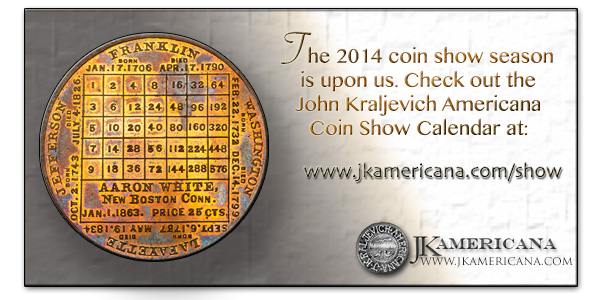
EBAY BANKNOTE SCAMMER INDICTED
A federal grand jury today indicted a Summit man on charges he scammed credit card companies and sellers on eBay by purchasing more than $122,000 worth of foreign and antique banknotes then claiming he never received them.
David D'Aries, 50, was charged with one count of mail fraud in the indictment announced by U.S. Attorney Paul Fishman.
In a release issued by his office, Fishman said D'Aries posed as a buyer of rare and antique foreign banknotes on the online auction site eBay between June 2007 and October 2012.
During that period, Fishman said, D'Aries won about 400 bids, paying for the banknotes either through PayPal or by credit card. After the sellers - from around the world - mailed the items to his home or a post office box in Chatham, D'Aries filed claims with PayPal or the credit card companies that he never received the banknotes or that they were unauthorized charges, Fishman said. They often issued him refunds, he said.
In turn, the sellers filed fraud claims with eBay, PayPal, the credit card companies and the U.S. Postal Service, Fishman said.
D'Aries is accused of using three different identities, including his dead father's and a person who lived with him, in the alleged scam.
In a June 30, 2011, search of his home, investigators found in a locked metal filing cabinet in his closet several thousand foreign banknotes and 165 pieces of mail from around the world addressed to him or one of the other identities he allegedly used, Fishman said.
In all, D'Aries scammed eBay, PayPal and the credit card companies out of $148,356, Fishman said.
To read the complete article, see:
Summit man accused of scamming banknote sellers on eBay
(www.nj.com/union/index.ssf/2014/01/summit_man_
accused_of_scamming_banknote_sellers_on_ebay.html)
THE EDWARDS CATALOGUE OF IMPERIAL GOLD COINS
James Edwards. A catalogue of imperial gold coins : to be sold at the prices affixed to each, On Monday the 8th of March, 1790, at Mr. Edwards's, No. 102, Pall-Mall. [London] : [s.n.].
In August 2013, the Harry W. Bass, Jr. Library acquired two exciting new additions for the rare book collections, detailed above. The first of mention is an 18th century fixed price list published in London (fig. 1), which I hope to expand on at a later date.
The sale took place on March 8, 1790, and was organized by the Edwards family, a group of eager bibliophiles originally from Halifax. The catalog is 22 pages and lists 400 lots, all kept together in a rather unremarkable soft paper binding. The full title of the sale appears as: A catalogue of imperial gold coins : to be sold at the prices affixed to each, On Monday the 8th of March, 1790, at Mr. Edwards's, No. 102, Pall-Mall.
Based on the address (no. 102 Pall-Mall, in London), we can identify this as the store of Edwards & Sons, established by James and John Edwards in 1784. The Edwards family had a long established tradition in the book industry, dating back to the 17th century. Richard Edwards (?1691-1767) was a schoolmaster and stationer and his son William (1722-1808) blossomed into an established bookseller, bookbinder, and publisher.
William began selling books through auction around 1749 and continued through 1760 in Halifax where he owned a bookshop. Two of his sons, James and John, worked in the Halifax bookshop before setting up shop in London in 1784. They opened Edwards & Sons at no. 102 Pall-Mall, the address which appears on their catalogs from January 1785 through 1791. James Edwards was primarily responsible for these sales, which focused primarily on paper-based materials, and soon established him as one of the most important antiquarian booksellers of his time.
He had a particular fascination with vellum bindings and his sales often included spectacular examples of fine bindings. In addition to being booksellers, the Edwards’ family was perhaps best known as bookbinders with extraordinary talent and artistic skill. They invented and patented a technique for painting under the surface of vellum, which creates a distinctive binding that today is known as “Edwards of Halifax” bindings.
This fixed price list of imperial gold coins seems to be the only occasion where Edwards sold anything other than books, manuscripts, prints, or designs. As noted on the cover, the sale took place at his bookshop at no. 102 Pall-Mall in a building that no longer exists, as the space was demolished in 1836-7 to make room for construction of the Reform Club, which occupies the site today.
It is unclear what prompted this unique sale of coins, but a note on the title-page verso states that: “to prevent any suspicion of partiality, those who intend to become purchasers are desired to deliver in, on Saturday [6 March], lists of such Medals as they choose, and each list shall be supplied as fully as possible, in the order they shall stand as to value.” This suggests that individuals purchasing the most items would get the first choices.
The Edwards’ catalog of imperial gold coins makes an excellent addition to the ANS Library collections for obvious reasons but it is also interesting to see how it fits into the wider context of rare books and binding history. Moreover, fixed price lists make up a substantial portion of the ANS Library collections, with several hundred in the general stacks as well as the rare book room.
However, unlike the auction catalogs in the library collection, the fixed price lists do not appear in the online library catalog, DONUM. They are arranged in alphabetical order according to the dealer-name who sells the coins and those that date to before 1950 are housed in the rare book room, while those after 1950 can be found on shelves in the general stacks.
Because of the sheer number of fixed price lists received, former librarians from the first half of the 20th century decided against cataloging individual lists. Although one card catalog tray devoted to these early lists does exist (and appears in the printed version of the ANS card catalog), it was not included when the card catalog was digitized in the late 1990s simply because it was not a complete record of the fixed price list holdings.
This means that we essentially need to start from scratch in order to create records for these important sales in our online catalog. Thankfully, our full-time library cataloger, Katie Rissetto, has caught us up on other important aspects of the cataloging and can soon begin to address this issue. This is one of the next big projects that we hope to tackle but is one that will also take some time to complete.
For more information on Edwards, see: Fine Bindings from Edwards of Halifax (www.york.ac.uk/library/collections/special-collections/treasures/edwards-fine-bindings/)
THE BOOK BAZARRE
GOLD QUARTER STATER MYSTERY
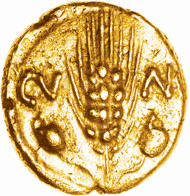
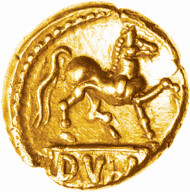
At 1.00pm on Saturday, 5 October 2013, metal detectorist Tom Lesurf, aged 19, found a small gold coin which raises a large question – a small gold coin which some of us believe was struck by a long-lost prince who died defending Britain again Roman invaders.
Tom was taking part in a three-day rally on a farm at Bourne End, Bedfordshire, along with about 400 other metdets including his father Eddie Lesurf.
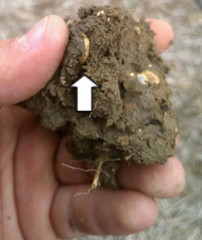 This is the first gold coin that Tom has found and it could well be the most important coin he will ever find.
This is the first gold coin that Tom has found and it could well be the most important coin he will ever find.
It is a 2,000-year-old gold quarter stater which was minted by a prince of the Catuvellauni (‘men excelling in battle’), probably around the time that the Roman emperor Claudius invaded Britain in AD 43.
Only three other coins are known of this prince – all of the same type – and all three came from the huge Hallaton war-hoards in east Leicestershire – over 5,000 coins, mostly silver coins of the Corieltavi (‘army of the broad land’) – which could have been collected to finance resistance to the Roman advance into the East Midlands c.AD 45-46 and which were first discovered in 2000 by metdet Ken Wallace.
The big question is this: who issued Tom’s exceedingly rare gold quarter stater?
To read the complete article, see: Has Tom found Togodumnus? (www.coinsweekly.com/en/Has-Tom-found-Togodumnus/8?&id=367&type=a)
WOMAN BUSTED FOR PASSING 'MOE MONEY'
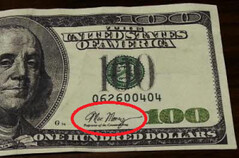 While for most consumers an attempt to pay with fake money probably amounts to joking “Ha ha, you don’t accept old Blockbuster cards as payment, do you? (wink!)” there are others out there who’ll go to great lengths to pull a fast one on retailers with counterfeit bills. That being said, having Moe Money’s signature on your $100 bills isn’t going to convince anyone that thing is anything but a fakety fake fake.
While for most consumers an attempt to pay with fake money probably amounts to joking “Ha ha, you don’t accept old Blockbuster cards as payment, do you? (wink!)” there are others out there who’ll go to great lengths to pull a fast one on retailers with counterfeit bills. That being said, having Moe Money’s signature on your $100 bills isn’t going to convince anyone that thing is anything but a fakety fake fake.
The 19-year-old suspect was charged with uttering a forged instrument*, forgery of instrument and obtaining property by false pretense, reports MyFox8.com, and one count of inducing giggles by using the name Moe Money in the first place. Police accuse her of trying to buy a gift card at a local Walgreens with a counterfeit $100, which led to her arrest. Cops later found $12,882 in fake money after her arrest, but it’s unclear if she’d ever successfully spent any more of the Moe Money money before.
Side note: Even if Moe Money was believable as a real guy, giving him the job title under his signature of “Proprietor of the Commonwealth” instead of say, Secretary of the Treasury or something is a giant tipoff too.
To read the complete article, see: Woman Busted For Fake $100 Bills Because “Moe Money” Isn’t In Charge Of Signing Currency (consumerist.com/2014/01/23/woman-busted-for-fake-100-bills-because-moe-money-isnt-in-charge-of-signing-currency/)

CHINESE LAI-SEE MONEY
Two elderly men were taken to hospital after fainting as they waited for banks to open to get new notes for their lai see.
The two men, both aged more than 80, had been in the queue for an hour when they collapsed, police said.
Long queues formed outside branches yesterday as people started to exchange new banknotes for the Lunar New Year.
Some banks opened early to help people get new notes.
An HSBC branch in Kwun Tong opened 30 minutes earlier than usual to help people, many of them elderly.
Workers at the bank distributed tokens beforehand to ease crowding. More staff were also deployed.
Apart from new bills, banks also provided well-kept, not-so-new notes for people to exchange.
A survey by the Democratic Alliance for the Betterment and Progress of Hong Kong showed that 70 percent prefer giving out HK$20 for lai see.
To read the complete article, see: Elderly faint in early lai see banknote queues (www.thestandard.com.hk/news_detail.asp?we_cat=4&art_id=141768&sid=41380754&con_type=1&d_str=20140122&fc=2)
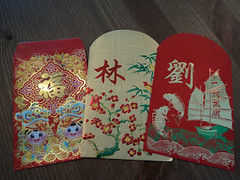 During the first few days of the Chinese New Year festival you will say many people giving each other small red and gold envelopes filled with money. This tradition is called Lai See and you give Lai See to people to wish them good fortune and prosperity in the year to come.
During the first few days of the Chinese New Year festival you will say many people giving each other small red and gold envelopes filled with money. This tradition is called Lai See and you give Lai See to people to wish them good fortune and prosperity in the year to come.
But giving Lai See is not as straightforward as it seems and there is a certain etiquette around who you give and how much you give. The general rule of thumb with Lai See is that it’s given from a senior to a junior. For example a boss will give Lai See to his employees, parents to their children and residents to doormen. Married couples will also give Lai See to their single friends.
The amount given varies widely depending on who the Lai See is given to. But no matter what the amount, the money should only be given in single notes and should never contain any coins. It’s also important that the notes are new and locals often stand in line at the bank for hours to obtain new fresh notes.
To read the complete article, see: Lai See (anotherdayinhongkong.blogspot.com/2011/02/lai-see.html)
The tradition of using brand new banknotes for lai-see uses a lot of resources and is bad for the environment.
It is common knowledge that large numbers of brand new banknotes are issued before every Chinese New Year because people like to use them as lai-see money. Last year, the three note-issuing banks in Hong Kong issued an additional 300 million brand new, mostly ten-dollar and twenty-dollar, banknotes with an aggregate face value of more than HK$24 billion.
The tradition of using brand new notes to symbolise a new beginning has a long history. But when you receive these brand new lai-see banknotes, do you ever think about the resources and logistics that go into providing them? Three hundred million banknotes weigh 300 metric tonnes, occupy 500 cubic metres of storage space, and could fill 20 twenty-foot containers. The three note-issuing banks need to arrange 500 trips with security escort to transport these brand new banknotes. Last but not the least, it takes 400 metric tonnes of cotton to make the special paper needed to print 300 million banknotes.
To read the complete article, see: Good-as-new Banknotes Equally Good for Lai-see Money (economists-pick-research.hktdc.com/business-news/article/Economic-Forum/Good-as-new-Banknotes-Equally-Good-for-Lai-see-Money/ef/en/1/1X000000/1X008OCO.htm)
CHINESE BANKNOTES STAMPED WITH FIREWALL-DEFECTING CODES
Eric Schena writes:
Here's an interesting article my wife Heather sent my way. Someone or some group in China have been stamping 1 Yuan notes with QR codes that bypass the "Great Firewall". It's a rather interesting modern use of money as a form of rebellion.
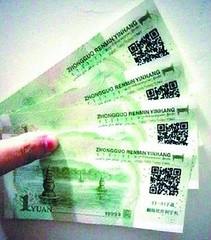 Centuries of invaders couldn't break the Great Wall of China, but a Chinese yuan can. Well, the "Great Firewall,” at least.
Centuries of invaders couldn't break the Great Wall of China, but a Chinese yuan can. Well, the "Great Firewall,” at least.
A series of one yuan banknotes became a whole lot more valuable after being stamped with a quick response (QR) code — a type of matrix barcode that, when scanned by a smartphone, sends a user to a website stored in the code — that circumvents the infamous firewall.
Beneath the stamped QR codes are the words: “Scan and download software to break the Internet firewall.” Doing so leads to an Amazon cloud link that hosts downloadable software to get around the firewall.
Typically, a website hosting anti-censorship software would itself be censored, but Bill Xia, president of Dynamic Internet Technology — a company that produces circumvention software — told The Epoch Times that there are ways to disguise the URLs of the QR codes. Because the files are stored on Amazon Web Services, if Chinese authorities wanted to block the links provided on the QR codes, they would presumably have to block Amazon in China, an act that could result in serious business problems.
As for who’s responsible for the stamped notes, many believe it to be the Falun Gong — a religious sect whose practice emphasizing morality and virtue has been persecuted by the Communist Party since 1999.
According to The Epoch Times, user "Qingwenwoding" wrote: "Only when you break through the firewall can you see China clearly." Many other commenters on popular websites asked for clearer photos of the stamped notes so that they could scan them from their computer screen.
To read the complete article, see: Chinese Banknotes Stamped With QR Codes Breach Great Firewall (mashable.com/2014/01/24/chinese-money-firewall/)
FEATURED WEB SITE: PHILIP AND HAROLD MERNICK
This week's Featured Web Site is maintained by my friend Philip and Harold Mernick of London. John Sallay recently discovered the site, which covers a wide range of topics, including:- London School Attendance Medals
- "Billy and Charleys", or the "Shadwell Forgeries"
- Bois Durci
- British Restaurant Tokens
- The Great Seals of Britain
- English Jettons
Philip Mernick adds:
We have many collecting interests. My English Jettons site is the most recent. I have been recording them for more than 20 years with the intension of producing a book. Unfortunately I couldn't figure out how to fit them into a book format. The web site means that it is now in the public domain although I wish I could find some way of turning it into a book.
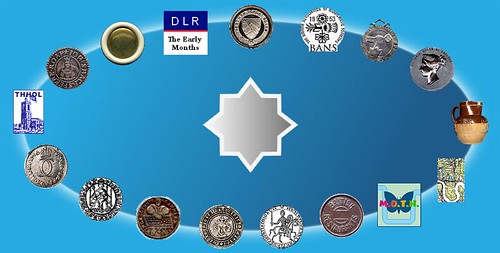
www.mernick.org.uk
